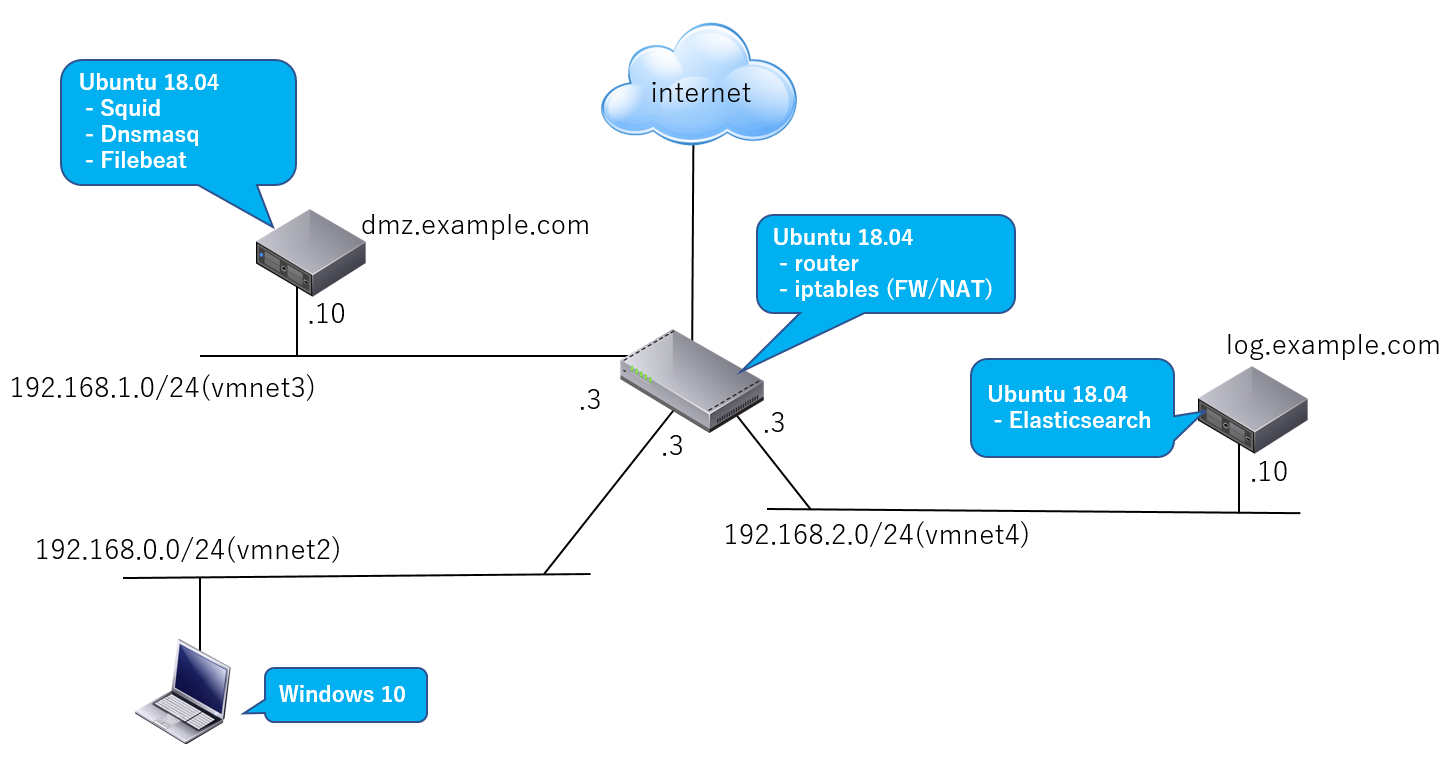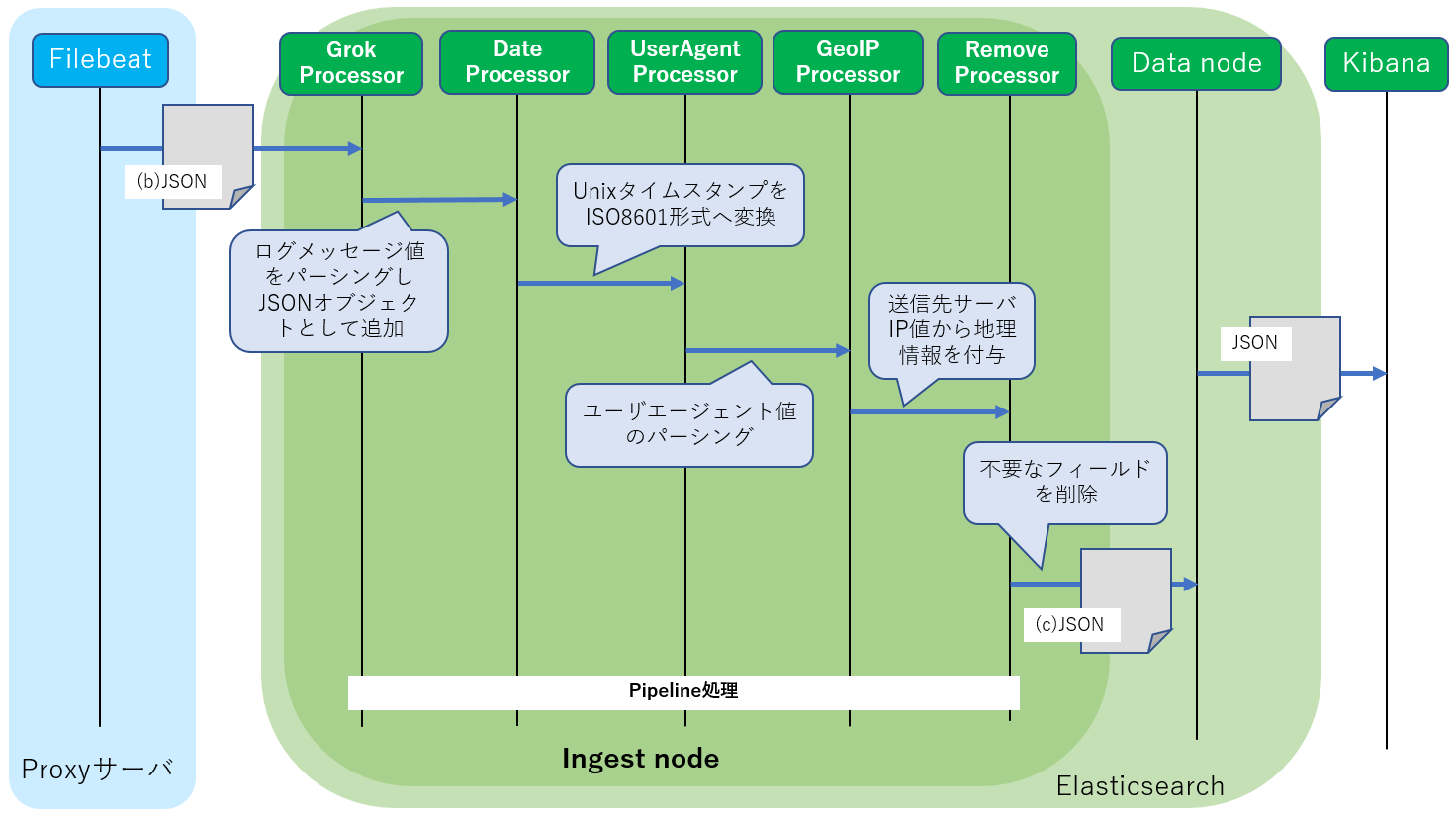はじめに
「標的型攻撃に対するJPCERT/CCのおすすめログ設定をElasticsearchで構築してみる(プロキシサーバ編)」ではJPCERT/CCによる「高度サイバー攻撃への対処におけるログの活用と分析方法」をもとに、以下の情報をElasticsearchへ出力するように設定してみました。
- URL
- HTTPリクエストメソッド
- タイムスタンプ
- 送信先サーバのFQDN
- 送信先サーバのIPアドレス
- 送信先サーバのポート番号
- 送信元クライアントのIPアドレス
- ユーザエージェント
- リファラ
- 送受信量
- 送信元クライアントのポート番号
※プロキシサーバとしてSquidを利用しています。
本記事ではこれらの情報出力をElastic Common Schema(ECS)へ対応させてみます。
- Elastic Common Schemaについて (Elastic社)
※本記事で作成するFilebeatモジュールやSquidの設定例はこちらへ置いておきました。
利用するソフトウェア
- OS: Ubuntu 18.04
- プロキシサーバ: Squid (3.5.27)
- DNSサーバ: Dnsmasq (2.79)
- Elasticsearch (7.3.2)
- Kibana (7.3.2)
- Filebeat (7.4.1)
- VMware Workstation Player等のVMソフトウェア
- Windows 10 (クライアントPC)
ネットワーク構成例
「標的型攻撃に対するJPCERT/CCのおすすめログ設定をElasticsearchで構築してみる(プロキシサーバ編)」から変更はありません。
| 説明 | |
|---|---|
| Webアクセス | Windows 10上のWebブラウザはインターネットへdmz.example.comで動作するプロキシサーバ(Squid)経由でアクセス |
| ログ | dmz.example.com上で動作するプロキシサーバのログをFilebeatがElasticsearch(log.example.com)へ転送 |
プロキシサーバ(Squid)のログ設定とフォーマット追加
特に変更はありません。
Squidの設定ファイル**/etc/squid/squid.conf**に以下の設定を追加します。Squidログフォーマットの詳細仕様についてはこちらを参照。
logformat combined %>a:%>p %[ui %[un "%rm %ru HTTP/%rv" %>Hs %>st %<st "%{Referer}>h" "%{User-Agent}>h" %Ss:%Sh [%ts%03tu] %<a:%<p %<A
access_log daemon:/var/log/squid/access.log combined
Squid用Filebeatモジュールの作成
「標的型攻撃に対するJPCERT/CCのおすすめログ設定をElasticsearchで構築してみる(プロキシサーバ編)」で作成したFilebeatモジュールをElastic Common Schema(ECS)へ対応させます。
Squid用モジュールのファイル構成
以下のような構成でモジュールのファイルを配置します(変更ありません)。
/usr/share/filebeat/
`- module/
`- squid/
|- module.yml
`- access/
|- manifest.yml
|- config/
| `- access.yml
`- ingest/
`- default.json
squid/access/manifest.ymlの設定
変更はありません。
module_version: 1.0
var:
- name: paths
default:
# Squidのログファイルパス(FilebeatへのInputソース)
- /var/log/squid/access.log*
# Ingestノードのパイプライン設定ファイルパス
ingest_pipeline: ingest/default.json
# 入力ソースの設定ファイルパス
input: config/access.yml
# Ingestノードのプラグインの指定
requires.processors:
- name: user_agent
# ユーザエージェント情報のパーシング
plugin: ingest-user-agent
- name: geoip
# 送信先サーバの地理情報の付加
plugin: ingest-geoip
squid/access/config/access.ymlの設定
変更はありません。
type: log
paths:
{{ range $i, $path := .paths }}
- {{$path}}
{{ end }}
exclude_files: [".gz$"]
squid/module.yml
変更はありません。
dashboards:
- id: Filebeat-Squid-Dashboard
squid/access/ingest/default.json
Ingestノードに注入するPipeline設定を記述します。利用するプロセッサは同じです。
| 説明 | |
|---|---|
| Grokプロセッサ | ログメッセージのテキストデータをパーシングしてJSON形式へ変換するプロセッサ。 パース形式を正規表現を組み合わせたパターンで記述するだけでOKです |
| Dateプロセッサ | SquidログのUNIXタイムスタンプからISO8601形式タイムスタンプへ変換します |
| User Agentプロセッサ | Webブラウザが送信するユーザエージェント情報(ブラウザ情報)をパーシングします |
| GeoIPプロセッサ | 接続先サーバIPの地理情報を追加します |
| Removeプロセッサ | 不要な情報を削除。 Grokによってパーシングされた後で不要な情報をElasticsearchへ保存する前に削除します |
| Renameプロセッサ | 上図には含まれていませんが、ログ内のフィールド名を変更します。例えばECSの名前(空間)へ変換するためによく利用されます |
設定の全体は以下の通りとなります。それぞれのプロセッサ設定について説明していきます。
{
"description": "Pipeline for parsing Squid access logs. Requires the geoip and user_agent plugins.",
"processors": [
{
"grok": {
"field": "message",
"patterns": [
"%{IPORHOST:source.address}:%{NUMBER:source.port} %{DATA:user.id} %{DATA:user.name} \"%{WORD:http.request.method} %{DATA:url.original} HTTP/%{NUMBER:http.version}\" %{NUMBER:http.response.status_code:long} %{NUMBER:http.request.bytes:long} %{NUMBER:http.response.bytes:long} \"%{DATA:http.request.referrer}\" \"%{DATA:user_agent.original}\" %{DATA:squid.access.squid_status}:%{DATA:squid.access.squid_hier} \\[%{NUMBER:squid.access.unix_time}\\] %{IPORHOST:destination.ip}:%{NUMBER:destination.port} %{IPORHOST:destination.domain}",
"%{IPORHOST:source.address}:%{NUMBER:source.port} %{DATA:user.id} %{DATA:user.name} \"%{WORD:http.request.method} %{DATA:url.original} HTTP/%{NUMBER:http.version}\" %{NUMBER:http.response.status_code:long} %{NUMBER:http.request.bytes:long} %{NUMBER:http.response.bytes:long} \"%{DATA:http.request.referrer}\" \"%{DATA:user_agent.original}\" %{DATA:squid.access.squid_status}:%{DATA:squid.access.squid_hier} \\[%{NUMBER:squid.access.unix_time}\\] -:- -"
],
"ignore_missing": true,
"ignore_failure": true
}
},
{
"grok": {
"field": "source.address",
"ignore_missing": true,
"ignore_failure": true,
"patterns": [
"^(%{IP:source.ip}|%{HOSTNAME:source.domain})$"
]
}
},
{
"rename": {
"field": "@timestamp",
"target_field": "event.created",
"ignore_failure": true
}
},
{
"date": {
"field": "squid.access.unix_time",
"target_field": "@timestamp",
"formats": [
"UNIX_MS"
],
"ignore_failure": true
}
},
{
"user_agent": {
"field": "user_agent.original",
"ignore_failure": true
}
},
{
"geoip": {
"field": "source.ip",
"target_field": "source.geo",
"ignore_missing": true
}
},
{
"geoip": {
"database_file": "GeoLite2-ASN.mmdb",
"field": "source.ip",
"target_field": "source.as",
"properties": [
"asn",
"organization_name"
],
"ignore_missing": true
}
},
{
"rename": {
"field": "source.as.asn",
"target_field": "source.as.number",
"ignore_missing": true
}
},
{
"rename": {
"field": "source.as.organization_name",
"target_field": "source.as.organization.name",
"ignore_missing": true
}
},
{
"geoip": {
"field": "destination.ip",
"target_field": "destination.geo",
"ignore_missing": true
}
},
{
"geoip": {
"database_file": "GeoLite2-ASN.mmdb",
"field": "destination.ip",
"target_field": "destination.as",
"properties": [
"asn",
"organization_name"
],
"ignore_missing": true
}
},
{
"rename": {
"field": "destination.as.asn",
"target_field": "destination.as.number",
"ignore_missing": true
}
},
{
"rename": {
"field": "destination.as.organization_name",
"target_field": "destination.as.organization.name",
"ignore_missing": true
}
},
{
"remove": {
"field": "message",
"ignore_missing": true,
"ignore_failure": true
}
}
],
"on_failure": [
{
"set": {
"field": "error.message",
"value": "{{ _ingest.on_failure_message }}"
}
}
]
}
GrokプロセッサによるログメッセージのJSON変換
GrokプロセッサによりFilebeatから転送されたJSONドキュメント内のmessageフィールドをパーシングし各フィールドを生成します。
※Grokのしくみについては「標的型攻撃に対するJPCERT/CCのおすすめログ設定をElasticsearchで構築してみる(プロキシサーバ編)」を参照してください。
変換先のテンプレート定義
まずGrokプロセッサがインデクスへ格納するログ情報のJSON形式(テンプレート)を定義します。テンプレートはデフォルトでは**/etc/filebeat/fields.ymlに定義されています。このファイルをmy_fields.yml**としてコピーしSquidモジュール用の定義を追加します。
cd /etc/filebeat
cp fields.yml my_fields.yml
Elastic Common Schema (ECS)を利用
ECSの定義は既に上述のfields.ymlに含まれていますので特に追加は必要ありません。
本モジュールでは以下のようにECSを利用します。
| 説明 | |
|---|---|
| source | クライアント(例:Webブラウザ)の接続元情報が設定されます |
| destination | 接続先サーバー(例:インターネットのWebサーバ)の接続先情報が設定されます |
| user | プロキシ認証情報が設定されます |
| http | HTTPプロトコル情報が設定されます |
| user_agent | UserAgent情報が設定されます |
| url | URL情報が設定されます |
Squid用モジュールのテンプレート定義
ECSに含まれていないSquid特有の情報については別途定義を**/etc/filebeat/my_fields.yml**へ追加します。
- key: squid
title: "Squid"
description: >
Squid Module
short_config: true
fields:
- name: squid
type: group
description: >
Squid fields.
fields:
- name: access
type: group
description: >
Contains fields for the Squid HTTP Server access logs.
fields:
- name: squid_status
type: keyword
description: >
Squid request status (TCP_MISS etc).
- name: squid_hier
type: keyword
description: >
Squid hierarchy status (DEFAULT_PARENT etc).
- name: unix_time
type: keyword
description: >
Timestamp by UNIX_MS.
Grokプロセッサの詳細
Grokプロセッサによるログメッセージのパーシング結果を変換するJSON形式を定義できました。次にプロセッサの設定を以下の通り行います。
{
"description": "Pipeline for parsing Squid access logs. Requires the geoip and user_agent plugins.",
"processors": [{
{
"grok": {
"field": "message",
"patterns": [
"%{IPORHOST:source.address}:%{NUMBER:source.port} %{DATA:user.id} %{DATA:user.name} \"%{WORD:http.request.method} %{DATA:url.original} HTTP/%{NUMBER:http.version}\" %{NUMBER:http.response.status_code:long} %{NUMBER:http.request.bytes:long} %{NUMBER:http.response.bytes:long} \"%{DATA:http.request.referrer}\" \"%{DATA:user_agent.original}\" %{DATA:squid.access.squid_status}:%{DATA:squid.access.squid_hier} \\[%{NUMBER:squid.access.unix_time}\\] %{IPORHOST:destination.ip}:%{NUMBER:destination.port} %{IPORHOST:destination.domain}",
"%{IPORHOST:source.address}:%{NUMBER:source.port} %{DATA:user.id} %{DATA:user.name} \"%{WORD:http.request.method} %{DATA:url.original} HTTP/%{NUMBER:http.version}\" %{NUMBER:http.response.status_code:long} %{NUMBER:http.request.bytes:long} %{NUMBER:http.response.bytes:long} \"%{DATA:http.request.referrer}\" \"%{DATA:user_agent.original}\" %{DATA:squid.access.squid_status}:%{DATA:squid.access.squid_hier} \\[%{NUMBER:squid.access.unix_time}\\] -:- -"
],
"ignore_missing": true,
"ignore_failure": true
}
},
{
"grok": {
"field": "source.address",
"ignore_missing": true,
"ignore_failure": true,
"patterns": [
"^(%{IP:source.ip}|%{HOSTNAME:source.domain})$"
]
}
},
......
}]
}
Squidの元ログは以下のように記録されます。
192.168.0.134:50435 - - \"GET http://xxx.example.com HTTP/1.1\" 200 2991 918 \"http://xxx.example.com/xxx.js\" \"Mozilla/5.0 (Windows NT 10.0; Win64; x64) AppleWebKit/537.36 (KHTML, like Gecko) Chrome/73.0.3683.86 Safari/537.36\" TCP_MISS:HIER_DIRECT [xxxxxxxx35237] 10.0.0.3:80 xxx.example.com
例えばsource.addressやsource.ipには「192.168.0.134」が、destination.ipには「10.0.0.3」が代入されます。またurl.originalには「xxx.example.com/xxx.js」が入ります。
設定の詳細についてはこちらを参照。
DateプロセッサによるISO8601形式タイムスタンプの追加
Squidのログで記録されるUNIXタイムスタンプからISO8601形式タイムスタンプを生成し追加します。
{
"description": "Pipeline for parsing Squid access logs. Requires the geoip and user_agent plugins.",
"processors": [{
......
{
"date": {
"field": "squid.access.unix_time",
"target_field": "@timestamp",
"formats": [
"UNIX_MS"
],
"ignore_failure": true
}
},
......
}],
......
}
User Agentプロセッサによるブラウザ情報のパーシング
ユーザエージェント情報(user_agent.originalフィールド)をパーシングします。
{
"description": "Pipeline for parsing Squid access logs. Requires the geoip and user_agent plugins.",
"processors": [{
......
{
"user_agent": {
"field": "user_agent.original",
"ignore_failure": true
}
},
......
}],
......
}
詳細についてはこちらを参照。
※以前はUser Agentプロセッサを利用するためにはElasticsearchへプラグインを別途追加する必要がありましたが、7.x.x系ではデフォルトで組み込まれています。
GeoIPプロセッサによる接続先サーバの地理情報の付加
接続元また接続先IPアドレスの地理情報を付加します。
{
"description": "Pipeline for parsing Squid access logs. Requires the geoip and user_agent plugins.",
"processors": [{
......
{
"geoip": {
"field": "source.ip",
"target_field": "source.geo",
"ignore_missing": true
}
},
{
"geoip": {
"database_file": "GeoLite2-ASN.mmdb",
"field": "source.ip",
"target_field": "source.as",
"properties": [
"asn",
"organization_name"
],
"ignore_missing": true
}
},
......
{
"geoip": {
"field": "destination.ip",
"target_field": "destination.geo",
"ignore_missing": true
}
},
{
"geoip": {
"database_file": "GeoLite2-ASN.mmdb",
"field": "destination.ip",
"target_field": "destination.as",
"properties": [
"asn",
"organization_name"
],
"ignore_missing": true
}
},
{
......
}],
......
}
詳細についてはこちらを参照。
※以前はGeoIPプロセッサを利用するためにはElasticsearchへプラグインを別途追加する必要がありましたが、7.x.x系ではデフォルトで組み込まれています。
Removeプロセッサによる不要な情報の削除
不要または冗長な情報を削除します。
パーシングしたmessageフィールドは不要のため削除します。
{
"description": "Pipeline for parsing Squid access logs. Requires the geoip and user_agent plugins.",
"processors": [{
......
}, {
"remove": {
"field": "message",
"ignore_missing": true,
"ignore_failure": true
}
......
}],
......
}
※後述の「Kibanaでログを確認」ではこの設定はデバッグ用にはずしてあります。必要に応じて追加してください。
詳細についてはこちらを参照。
Filebeatモジュールの設定手順
Squid用のモジュールが完成しましたのでそれをdmz.example.comへデプロイします。
モジュールの設定ファイル作成
特に変更はありません。
/etc/filebeat/
`- modules.d/
`- squid.yml.disabled
- module: squid
# Access logs
access:
enabled: true
# Set custom paths for the log files. If left empty,
# Filebeat will choose the paths depending on your OS.
#var.paths:
モジュールのテンプレート設定を追加
/etc/filebeat/
`- my_fields.yml
さきほど作成したmy_fields.ymlのパスをFilebeatの設定ファイル(/etc/filebeat/filebeat.yml)で変更します。以下のsetup.template.fieldsで説明します。
Filebeatの設定ファイルを修正
/etc/filebeat/
`- filebeat.yml
| 説明 | |
|---|---|
| hosts: ["log.example.com:9200"] | Elasticsearchが動作するホストアドレスとポート番号を指定 |
| filebeat.overwrite_pipelines: true | Elasticsearchへの接続毎にIngestノードのパイプライン設定を注入(デバッグ用) |
| setup.template.enabled: true | テンプレート設定の注入を有効化 |
| setup.template.fields: "/etc/filebeat/my_fields.yml" | テンプレート設定ファイルの場所を変更 |
| setup.template.overwrite: true | 既存のテンプレート設定を更新 |
| setup.ilm.enabled: false | 本記事ではILMは無効にしておきます。そのためインデクスは日付単位で生成されます |
詳細は**/etc/filebeat/filebeat.reference.yml**を参照してください。
hosts: ["log.example.com:9200"]
# 運用時にはコメントアウト
filebeat.overwrite_pipelines: true
setup.template.enabled: true
setup.template.fields: "/etc/filebeat/my_fields.yml"
setup.template.overwrite: true
setup.ilm.enabled: false
設定を確認します。log.example.com:9200(Elasticsearch)への接続確認も行っておきましょう。
cd /etc/filebeat
/usr/share/filebeat/bin/filebeat test config
/usr/share/filebeat/bin/filebeat test output
Filebeatを再起動します。
systemctl restart filebeat.service
モジュールの有効化
以上の設定作業が終わったらSquid用のモジュールを有効化します。
filebeat modules enable squid
モジュールのテンプレート設定をElasticsearchへ注入
filebeat setup --index-management
モジュールのパイプライン設定をElasticsearchへ注入
filebeat setup --pipelines -modules squid
補足
テンプレートの参照
curl -XGET http://log.example.com:9200/_template/filebeat-*?pretty
テンプレートの削除
curl -XDELETE http://log.example.com:9200/_template/filebeat-*
パイプライン設定の参照
curl -XGET http://log.example.com:9200/_ingest/pipeline/filebeat-*?pretty
パイプライン設定の削除
curl -XDELETE http://log.example.com:9200/_ingest/pipeline/filebeat-*
registryファイルのクリア
rm /var/lib/filebeat/registry
Kibanaでログを確認
- Management/Create Index Patternにて filebeat-*を指定してインデクスパターンを生成
- Discoverにてパーシングされたログを確認できます。

{
"_index": "filebeat-7.4.1-2019.10.24",
"_type": "_doc",
"_id": "X-Ly_xxxu7mxxxxxxxxxxxxxxxxx",
"_version": 1,
"_score": null,
"_source": {
"agent": {
"hostname": "dmz_server",
"id": "xxxxxxx-xxxx-xxxx-xxxx-xxxxxx",
"type": "filebeat",
"ephemeral_id": "xxxxxxx-xxxx-xxx-xxxx-xxxxxxxxxxxxxxxxx",
"version": "7.4.1"
},
"log": {
"file": {
"path": "/var/log/squid/access.log"
},
"offset": 204461
},
"destination": {
"geo": {
"continent_name": "North America",
"country_iso_code": "US",
"location": {
"lon": -97.822,
"lat": 37.751
}
},
"as": {
"number": 15169,
"organization": {
"name": "Google LLC"
}
},
"port": "443",
"domain": "www.google.com",
"ip": "172.217.161.36"
},
"source": {
"address": "192.168.0.134",
"port": "51325",
"ip": "192.168.0.134"
},
"message": "192.168.0.134:51325 - - \"CONNECT www.google.com:443 HTTP/1.1\" 200 3541 66346 \"-\" \"Mozilla/5.0 (Windows NT 10.0; Win64; x64; rv:70.0) Gecko/20100101 Firefox/70.0\" TCP_TUNNEL:HIER_DIRECT [1571940395920] 172.217.161.36:443 www.google.com",
"fileset": {
"name": "access"
},
"url": {
"original": "www.google.com:443"
},
"input": {
"type": "log"
},
"@timestamp": "2019-10-24T18:06:35.920Z",
"ecs": {
"version": "1.1.0"
},
"service": {
"type": "squid"
},
"host": {
"hostname": "dmz_server",
"os": {
"kernel": "4.15.0-66-generic",
"codename": "bionic",
"name": "Ubuntu",
"family": "debian",
"version": "18.04.1 LTS (Bionic Beaver)",
"platform": "ubuntu"
},
"containerized": false,
"name": "dmz_server",
"id": "xxxxxxxxxxxxxxxxxxxxxxx",
"architecture": "x86_64"
},
"http": {
"request": {
"referrer": "-",
"method": "CONNECT",
"bytes": 3541
},
"response": {
"status_code": 200,
"bytes": 66346
},
"version": "1.1"
},
"squid": {
"access": {
"squid_hier": "HIER_DIRECT",
"unix_time": "1571940395920",
"squid_status": "TCP_TUNNEL"
}
},
"event": {
"created": "2019-10-24T18:06:37.572Z",
"module": "squid",
"dataset": "squid.access"
},
"user": {
"name": "-",
"id": "-"
},
"user_agent": {
"original": "Mozilla/5.0 (Windows NT 10.0; Win64; x64; rv:70.0) Gecko/20100101 Firefox/70.0",
"os": {
"name": "Windows 10"
},
"name": "Firefox",
"device": {
"name": "Other"
},
"version": "70.0"
}
},
"fields": {
"suricata.eve.timestamp": [
"2019-10-24T18:06:35.920Z"
],
"@timestamp": [
"2019-10-24T18:06:35.920Z"
],
"event.created": [
"2019-10-24T18:06:37.572Z"
]
},
"highlight": {
"suricata.eve.http.url": [
"@kibana-highlighted-field@www.google.com:443@/kibana-highlighted-field@"
],
"url.original": [
"@kibana-highlighted-field@www.google.com:443@/kibana-highlighted-field@"
]
},
"sort": [
01234567890
]
}
まとめ
Filebeatで収集するSquidログをElastic Common Schema (ECS)へ対応させてみました。こうすることで例えばElastic SIEMで分析する際にもSquidのログを利用可能となります。

